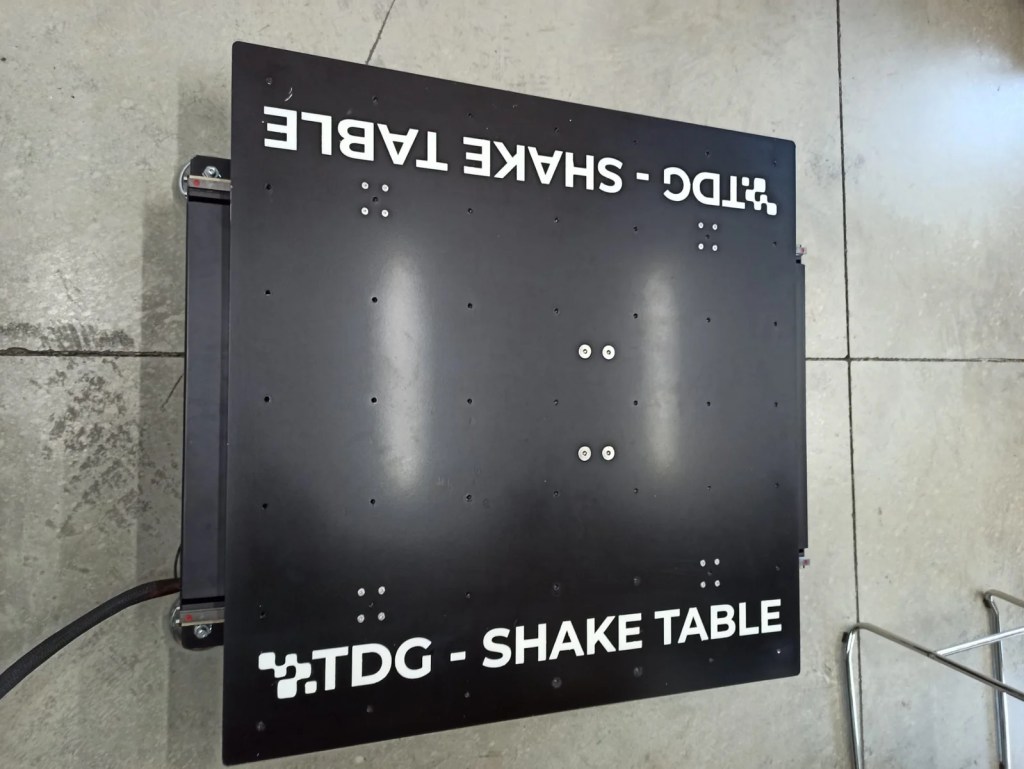The QuakeLogic offers the 250-kg Shake Table, which is designed based on advanced engineering principles to simulate seismic activity for testing and research purposes. The structural framework consists of a robust, precision-engineered table platform supported by high-strength steel components. The platform can support up to 250 kg of test specimens.
The top table of the 1-axis system has dimensions of 100×100 cm (length by width) and a capacity of ±1g at 250 kg. It offers a stroke of ± 200 mm (total stroke of 400 mm) and operates using an electro-mechanical mechanism to generate precise and controlled movements. This system is integrated with high-fidelity sensor and actuator that translate electrical signals into physical motion, replicating the complex dynamics of earthquake waves. The control system uses real-time feedback mechanisms to ensure accuracy and repeatability of the simulations, making it an essential tool for structural and seismic testing.

Function:
The primary function of the 250-kg Shake Table is to provide a controlled environment for simulating seismic events. This equipment is designed to replicate ground motion by subjecting test specimens to a wide range of earthquake-induced vibrations in addition to signals such as sine wave, which are essential for comprehensive testing.
The product comes with EASYTEST PC control software, allowing for precise control and monitoring of the shake table’s operations. The EASYTEST is used for setting up test parameters, including the amplitude, frequency, and duration of the simulated earthquakes. This software enhances the usability of the system, making it accessible for both novice and experienced users.
Use Cases:
The QuakeLogic 250-kg Shake Table is used extensively in research, education, and industry for seismic testing and analysis. Its applications include:
- Structural Engineering Research: Universities and research institutions use the shake table to study the effects of earthquakes on various building materials and structural systems. This research is vital for developing new construction techniques and materials that can withstand seismic events.
- Civil Engineering Education: The shake table serves as a practical tool for educating civil engineering students about seismic design principles. It provides hands-on experience in understanding how structures behave under earthquake conditions.
- Seismic Certification and Testing: Manufacturers of construction materials and structural components utilize the shake table to certify their products’ seismic performance. This ensures that the products meet the necessary safety standards and regulatory requirements.
- Disaster Preparedness and Mitigation: Government agencies and organizations involved in disaster management use the shake table to develop and test mitigation strategies. This helps in improving building codes and enhancing the resilience of infrastructure against earthquakes.
- Commercial and Industrial Applications: The shake table is employed by engineering firms and construction companies for designing and testing innovative solutions for earthquake-resistant structures. This includes retrofitting existing buildings and designing new structures that comply with modern seismic standards.
Overall, the 250-kg Shake Table is an indispensable tool for advancing the understanding of seismic phenomena and improving the safety and resilience of structures in earthquake-prone regions.
To visit product page, click HERE.
For any further details or clarification, please do not hesitate to contact us directly at sales@quakelogic.net or call us at +1-916-899-0391.



